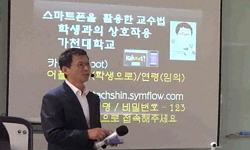(Background and Purpose) In the modern educational landscape, the configuration and design of space play crucial roles in enhancing learners' creativity, interaction, and concentration, ultimately maximizing learning effectiveness. Particularly in fie...
http://chineseinput.net/에서 pinyin(병음)방식으로 중국어를 변환할 수 있습니다.
변환된 중국어를 복사하여 사용하시면 됩니다.
- 中文 을 입력하시려면 zhongwen을 입력하시고 space를누르시면됩니다.
- 北京 을 입력하시려면 beijing을 입력하시고 space를 누르시면 됩니다.

A Study on the Improvement of the Learning and Creative Spaces on the 7th Floor of Hongmungwan at Hongik University
한글로보기https://www.riss.kr/link?id=A109636897
- 저자
- 발행기관
- 학술지명
- 권호사항
-
발행연도
2025
-
작성언어
English
-
주제어
Educational space ; Space improvement ; Collaborative space ; Flexibility ; Interaction ; 교육공간 ; 공간개선 ; 협업공간 ; 유연함 ; 상호작용
-
등재정보
KCI등재
-
자료형태
학술저널
- 발행기관 URL
-
수록면
53-64(12쪽)
- 제공처
-
0
상세조회 -
0
다운로드
부가정보
다국어 초록 (Multilingual Abstract)
Secondly, the use of space at renowned international design schools such as Harvard GSD and Cooper Union was analyzed to identify the essential spatial elements necessary for creative education. Thirdly, the current use of space on the 7th floor of Hongmungwan at Hongik University was surveyed to identify elements that require improvement, and based on these analyses, specific spatial design improvements suitable for enhancing creativity in visual design education were proposed.
(Results) The main improvement proposals derived from this study are as follows: First, reconfiguring the space around a flexible corridor, moving away from the fixed classroom setup to enable various learning activities and creative experiments. Second, utilizing ceiling spaces and walls to build infrastructure that supports installation art, projection mapping, and other visual experiments. Third, expanding open learning spaces to enhance communication and collaboration among students, creating an environment where ideas can be freely shared and discussed. These improvements are expected to stimulate students' creative ideas and foster interactions, thus enhancing the quality of education. (Conclusions) The design improvements proposed through this research demonstrate the potential for innovative transformations in the educational environment of Hongik University's Hongmungwan 7th floor, specifically designed for design education spaces.
These spatial design enhancements will play a crucial role in boosting students' creativity and collaborative skills, serving as important references for future planning of design education spaces. Additionally, this research can serve as foundational material for space improvement initiatives in design departments and inspire similar projects aimed at revitalizing learning and creative spaces at other educational institutions both domestically and internationally.
(Background and Purpose) In the modern educational landscape, the configuration and design of space play crucial roles in enhancing learners' creativity, interaction, and concentration, ultimately maximizing learning effectiveness. Particularly in fields like design education that emphasize creative thinking and collaboration, the configuration of educational spaces becomes increasingly critical. The existing educational spaces at Hongik University's Department of Visual Communication Design on the 7th floor of Hongmungwan have a closed and segregated structure that limits communication and the free exchange of ideas among students. This study aims to benchmark spatial design practices from world-renowned design schools to propose improvements for the environment on the 7th floor of Hongmungwan at Hongik University that would maximize students' creative outputs. (Method) This study is based on a proposed planning design for the spatial reorganization project at Hongik University's Department of Visual Communication Design. The design research method included: Firstly, prior research on educational space configurations that can enhance students' creativity was reviewed.
Secondly, the use of space at renowned international design schools such as Harvard GSD and Cooper Union was analyzed to identify the essential spatial elements necessary for creative education. Thirdly, the current use of space on the 7th floor of Hongmungwan at Hongik University was surveyed to identify elements that require improvement, and based on these analyses, specific spatial design improvements suitable for enhancing creativity in visual design education were proposed.
(Results) The main improvement proposals derived from this study are as follows: First, reconfiguring the space around a flexible corridor, moving away from the fixed classroom setup to enable various learning activities and creative experiments. Second, utilizing ceiling spaces and walls to build infrastructure that supports installation art, projection mapping, and other visual experiments. Third, expanding open learning spaces to enhance communication and collaboration among students, creating an environment where ideas can be freely shared and discussed. These improvements are expected to stimulate students' creative ideas and foster interactions, thus enhancing the quality of education. (Conclusions) The design improvements proposed through this research demonstrate the potential for innovative transformations in the educational environment of Hongik University's Hongmungwan 7th floor, specifically designed for design education spaces.
These spatial design enhancements will play a crucial role in boosting students' creativity and collaborative skills, serving as important references for future planning of design education spaces. Additionally, this research can serve as foundational material for space improvement initiatives in design departments and inspire similar projects aimed at revitalizing learning and creative spaces at other educational institutions both domestically and internationally.
동일학술지(권/호) 다른 논문
-
Exploring the Applicability of ChatGPT in the Landscape Architecture Design Process
- 한국공간디자인학회
- 이하나
- 2025
- KCI등재
-
A Case Analysis on the Importance of Interactive Design Factors in the Metaverse Brand Space
- 한국공간디자인학회
- 이련경
- 2025
- KCI등재
-
A Study on Biophilic Elements in Workplace Meditation Spaces
- 한국공간디자인학회
- 임정화
- 2025
- KCI등재
-
- 한국공간디자인학회
- 정형원
- 2025
- KCI등재




 KCI
KCI KISS
KISS






